Effects of Wildlife Crime on African and Asian Elephant Popluations
| ✅ Paper Type: Free Essay | ✅ Subject: Environmental Studies |
| ✅ Wordcount: 3211 words | ✅ Published: 23 Sep 2019 |
Facing extinction; a study into the effects of Wildlife Crime on both African and Asian Elephant (Loxodonta africana, Elephas maximus) populations.
Introduction
Both African and Asian Elephants are listed on the IUCN red list with ratings of vulnerable and endangered respectively. Despite conservation efforts aiding the increase in African Elephant populations, Asian Elephant populations are still decreasing. Both African and Asian Elephants are protected under CITES (Convention on International Trade in Endangered Species of Wild Fauna and Flora) Appendix I except populations of Botswana, Namibia, South Africa and Zimbabwe where African Elephants are protected under Appendix II (Blanc, 2008; Choudhury et al., 2008). Appendix I protects all organisms that are at risk of extinction by disallowing any international trade in these species except when it is not for commercial purposes. Appendix II organisms are not considered to be in immediate danger of extinction but consist of species whose populations are showing a concerning decline. Strict regulations to prevent over-exploitation is in place regarding trading of these organisms but trading is still permitted (Stiles, 2004).
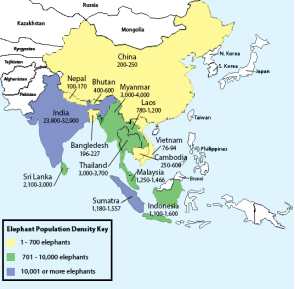
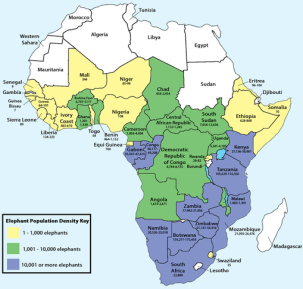 As older Elephants have bigger tusks, they are more desirable to poachers however the removal of older generations of Elephants with larger tusks is having disastrous effects on Elephant populations and their reproduction and is ultimately driving them towards extinction (Gobush et al. 2008; Ishengoma et al. 2008). Despite the rapid decrease of Elephant populations during the 1970’s and 1980’s and the consequent banning of Ivory trade, poaching is still prevalent today (Wasser et al., 2010). Wild elephants are also facing new threats from human-wildlife conflict. Due to an increase in urbanisation, elephant populations are being forced to live in smaller areas with growing contact with humans and livestock (Chen et al., 2013; Gillson and Lindsay, 2003). In China alone, urbanisation has more than doubled between 1960 and 2010 (Figure 3) and this has caused a decrease in Elephant populations within China with most Asian Elephants now residing in India. (Figure 1) Most African Elephants are found in the south away from growing populations in the north (Figure 2).
As older Elephants have bigger tusks, they are more desirable to poachers however the removal of older generations of Elephants with larger tusks is having disastrous effects on Elephant populations and their reproduction and is ultimately driving them towards extinction (Gobush et al. 2008; Ishengoma et al. 2008). Despite the rapid decrease of Elephant populations during the 1970’s and 1980’s and the consequent banning of Ivory trade, poaching is still prevalent today (Wasser et al., 2010). Wild elephants are also facing new threats from human-wildlife conflict. Due to an increase in urbanisation, elephant populations are being forced to live in smaller areas with growing contact with humans and livestock (Chen et al., 2013; Gillson and Lindsay, 2003). In China alone, urbanisation has more than doubled between 1960 and 2010 (Figure 3) and this has caused a decrease in Elephant populations within China with most Asian Elephants now residing in India. (Figure 1) Most African Elephants are found in the south away from growing populations in the north (Figure 2).
Figure 2. The population density of African Elephants. (Association of Zoos and Aquariums, 2009)
Figure 1. The population density of Asian Elephants. (Association of Zoos and Aquariums, 2009)
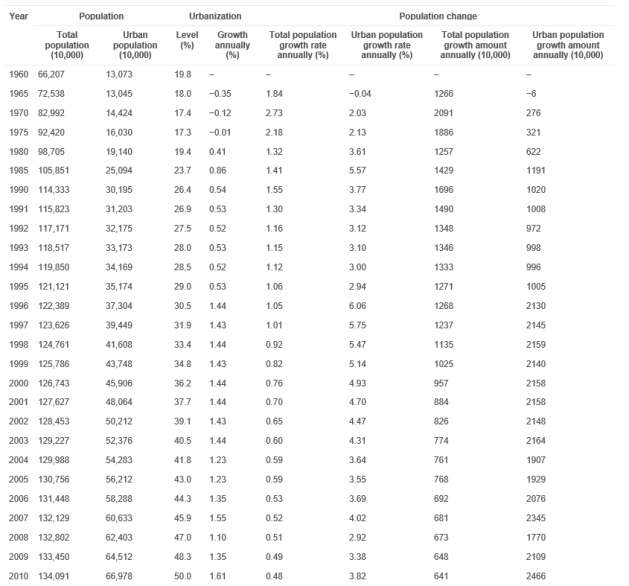
Figure 3: The status of Chinas urbanisation between 1960 and 2010. (Chen et al., 2013)
The Ivory trade
Ivory is the main component of mammalian teeth (Espinoza et al., 1992) and has primarily been associated with Elephants due to their protruding tusks. The tusks of Elephants grow throughout their life (Weissengruber et al, 2005). When removing an Elephants tusk the Elephant would have to be killed as some of the tusk protrudes into the elephant’s head and would need to be carved out of the skull (Figure 1). Tusks are sexually dimorphic in Asian Elephants with males having longer, and thicker tusks whereas both male and female African Elephants have long tusks (Chelliah and Sukumar, 2013). Some African Elephants have been found to have no tusks which is believed to be genetic and is also thought to be the result of poaching as Elephants are evolving to have shorter or no tusks (Whitehouse, 2002). This however puts Elephants at a disadvantage as they have been observed using their tusks in fighting for dominance and digging for minerals (Chelliah and Sukumar, 2013). Wildlife crime is not only potentially causing extinction in the long term but in the short term is forcing Elephants to evolve as a means of survival by reducing their desirability to poachers.
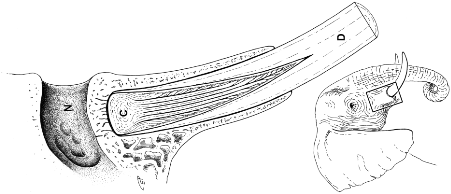
Figure 2. Longitudinal section through the right tusk of an African elephant. N, Nasal Cavity; C, Cavity containing the nerves; D, Dentine (Ivory). (Weissengruber et al, 2005).
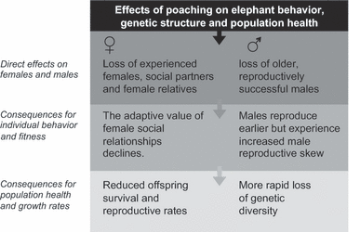 When discussing Elephants and their conservation there is an automatic association to the ivory trade and poaching. Ivory has often been traded for the idea that it shows wealth status especially within Chinese middle-class communities, this can be seen in figure 5 with most legal ivory retailers being in richer parts of China such as Beijing, Shanghai, Guangzhou, and Fuzhou. As the population in China is continually increasing there has become an even greater demand for ivory (Gao and Clark, 2014). Poaching has disastrous effects on Elephant populations firstly because of the immediate effect of the death of an Elephant and secondly, the long-term effects such as impact on reproduction within elephant populations. As female Elephants reach sexual maturity at 10-12 years of age and prefer to mate with older male elephants (Hollister-Smith et al., 2007) it is important to ensure they are well protected in the wild to allow for them time to reproduce. The average Elephant pregnancy lasts 22 months with age between offspring ranging between 4-8 years (Foley et al., 2001). The impact poaching has on the genetic structure of Elephants can be seen in figure 8. For females, losing matriarchal and older members of the herd may negatively influence the reproductive success and consequently population growth of the herd (Gobush et al., 2008). For males, poaching can lead to reproductive distortion thus decreasing the genetic diversity in the group.
When discussing Elephants and their conservation there is an automatic association to the ivory trade and poaching. Ivory has often been traded for the idea that it shows wealth status especially within Chinese middle-class communities, this can be seen in figure 5 with most legal ivory retailers being in richer parts of China such as Beijing, Shanghai, Guangzhou, and Fuzhou. As the population in China is continually increasing there has become an even greater demand for ivory (Gao and Clark, 2014). Poaching has disastrous effects on Elephant populations firstly because of the immediate effect of the death of an Elephant and secondly, the long-term effects such as impact on reproduction within elephant populations. As female Elephants reach sexual maturity at 10-12 years of age and prefer to mate with older male elephants (Hollister-Smith et al., 2007) it is important to ensure they are well protected in the wild to allow for them time to reproduce. The average Elephant pregnancy lasts 22 months with age between offspring ranging between 4-8 years (Foley et al., 2001). The impact poaching has on the genetic structure of Elephants can be seen in figure 8. For females, losing matriarchal and older members of the herd may negatively influence the reproductive success and consequently population growth of the herd (Gobush et al., 2008). For males, poaching can lead to reproductive distortion thus decreasing the genetic diversity in the group.
Figure 8. The effect of poaching on evolutionary social relationships in core Elephant groups. (Elizabeth and Archie, 2011)
Gobush et al., 2008 studied adult female elephants over 25 months to assess the long‐term impacts of poaching and found that 15 years on from poaching, female herds that lost older members or matriarchs had a lower reproductive success than those who’s older members remained intact. Their results also show that disrupted family bonds caused an increase in glucocorticoids which relates to stress within the herd, those in the herd that still had mother-daughter relatedness were able to maintain low stress levels. Similarly, Ruggiero, 1990 found that poaching of matriarchal members of herds resulted in long term impacts of lower reproductive success due to young bulls not yet reaching maturity and that the herds were now being led by young, inexperienced cows. However, a study by Ishengoma et.al., 2008 found that although poaching resulted in short term effects of reproductive success in male bulls the long-term effects were insignificant and male bulls were able to breed successfully with female cows.
By 1970 prosperity grew increasing the demand for Ivory and thus causing a decrease in Elephant populations as Ivory trading grew in popularity (Figure 6; Figure 7; Hilborn et al., 2006). This caused the number of wild African Elephants to rapidly decrease during the 1970’s and 80’s with populations reducing to 600,000 from 1.3 million (Douglas-Hamilton, 2009). Because of this CITES introduced controls including the use of permits and monitoring of legal Ivory trading however this is believed to have only increased the appeal of Ivory and criminal organisations involved in the illegal trade to take over the legal trade making Ivory more expensive with set prices (Bennett, 2015; Heltberg, 2001). Finally, as of 1990, Elephants were moved to appendix I of CITES which consists of organisms that are the most at risk of becoming extinct. All international trade is forbidden unless a permit allowing trade for non-commercial purposes has been granted (Stiles, 2004).
Despite the effects of poaching and the ivory trade resulting in a rapid decline of Elephant populations, there was opposition to the ban, mainly from South African countries who claim the money they received from Ivory sales helped with conserving their Elephants (Kelso, 1995). CITES voted in 1997 to allow the populations of African elephants in Botswana, Namibia and Zimbabwe to be moved to Appendix II allowing ivory stockpiles to be auctioned to Japanese traders (Underwood et al., 2013). The auction took place in 1999 and was on an experimental basis, the aim was to reduce the number of Elephants that were illegally poached by auctioning Ivory in this way. However, it is believed that this only resulted in an increase in Ivory demand giving poachers and illegal traders more incentive (Barbier et al., 2013).
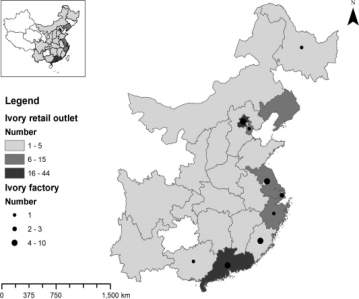 In 2008 China was granted trading permission to disperse its Ivory stockpile and was supported by WWF (World Wide Fund for Nature) and TRAFFIC (the wildlife trade monitoring network) with the aim that the legal trade of Ivory in this way would decrease the price of Ivory set by criminals and thus cause illegal traders and poachers to lose incentive (Vandergrift, 2013). However, due to the publicity surrounding the killing of Elephants and the Ivory trade the demand and popularity for Ivory had diminished (Stiles and Martin, 2001). This encouraged China to ban all ivory sales and trading in 2018 (Aryal et al., 2018).
In 2008 China was granted trading permission to disperse its Ivory stockpile and was supported by WWF (World Wide Fund for Nature) and TRAFFIC (the wildlife trade monitoring network) with the aim that the legal trade of Ivory in this way would decrease the price of Ivory set by criminals and thus cause illegal traders and poachers to lose incentive (Vandergrift, 2013). However, due to the publicity surrounding the killing of Elephants and the Ivory trade the demand and popularity for Ivory had diminished (Stiles and Martin, 2001). This encouraged China to ban all ivory sales and trading in 2018 (Aryal et al., 2018).
Figure 5. The distribution of legal ivory market in China in 2013. (Gao and Clark, 2014)

Figure 6. Elephant population changes since 1950 showing the decrease due to poaching in the 1970’s and 1980’s followed by an increase after 1990 when the ivory trade ban was implemented.
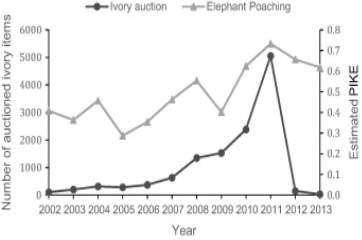
Figure 7. The number of ivory items traded in the auction market 2002–2013 and the estimated proportion of illegally killed elephants (Gao and Clark, 2014)
As some populations of Elephants are increasing such as those in Kenya (Figure 8) some of those in favour of the ivory trade suggest that as Elephant populations are increasing, they aren’t as endangered as they are made out to be. However, the increase in population of the elephants only occurred after the ban had been imposed suggesting that had the ban not been in place the abundance of Elephants would still be declining (Hilborn et al., 2006).
The Southern African Development Community (SADC) argue that there should be a trade in legitimate Ivory which is gathered from an Elephant that died a natural death in order to maintain the income they receive from Ivory sales. They claim that the profit from the Ivory trade is used to help with Elephant conservation (Wu et al., 2016). However, this is impractical as the amount earned from legal ivory trade is much lower than the amount earned by tourism (Van-Kooten, 2008). Live elephants are often used as a tourist attraction and the killing of the elephant populations will cause countries to lose significant amounts of money.
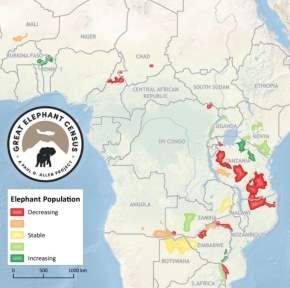
Figure 8. Elephant population trends in Africa based on the past ten years, 2006-2016 (Chase et al. 2016).
Human-Elephant conflict
Humans and animals have always struggled to co-exist, be it competition for resources such as land or the threat animals pose to humans (Hoare, R., 2000; Sitati and Walpole, 2006). As urbanisation increases the chances of contact between Elephants and villages also increases resulting in conflict due to the threat the Elephants pose to villages Fernando et al., 2005). Due to Elephants destroying crops many villages have introduced fencing but this has caused a skew in migration patterns for elephants (Hayward and Kerley, 2009) this has raised the question on how can the conflict be resolved between humans and elephants.
Elephant habitat consists of_____for Asian elephants and ________for African elepahant and with urbanisation in _____ growing, many of the Elephants habitats are now closer to towns and/or villages (figure, ref). Elehants habitats consist of _______ (ref, image) and their distribution can be seen in figure 2 for Asian and 3 for African. E can see from both figures that those closes to towns number are dwindling as can be seen from someone et al. who found the abundance of af elephants to be ______ compred to years ago at ____ showing a decline of_______. Elephant populations in Africa alone are showing a greater decrease in numbers than increase (figure 1). range from Africa to asia with x amount in Africa and x amount in asia, figurre blah shows the distribution of elephants in both Africa and asia and when comparing this with figure blah we can see how their distribution has dwindled. Elephants live in forests or blah (figure blah) and figure blah shows how much forest has been left in Africa due to urbanization etc.
Having live elephants also benefits other wildlife. Elephants help convert forests into grasslands providing new habitats for a range of wildlife (reference). Therefore, if the elephant population is reduced due to wildlife crime, it indirectly has an adverse effect on the habitats of other animals. In the 1970’s, the Tsavo National Park in Kenya found that a decrease in elephant population led to a decrease in the population of other animals such as zebras (reference).
However, Elepahnts have been known to kill livestock. A study by (reference) found that in villages that were closer to elepahtns more livestock died yearly resulting in money loss etc.
Hard to regulate
Illegal trade is difficult to tell apart from legal trade because testing each batch of Ivory with DNA testing will be costly and difficult (reference). Many conservationists argue that the legal trade in ivory is also used as a cover for illegal trade (reference). Although there is a ban on the international trade in elephant ivory, the sale of antique ivory such as that obtained from mammoths (reference) is still permitted in many countries (reference). In 2016, CITES Parties agreed that all ivory trading should be illegal and the USA, France and China has agreed to this (reference).
Conclusion
If we consider that Elephants are facing extinction and human populations are growing a suitable solution which protects both umans and elephants could be the relocation of elephants. By relocating elephants to one area would encouarage mating within herds as more herds are available for fission and fusin (reference). In 2001, Kruger National Park in south Africa moved some of it’s elephants to Mozambique and found this increased the population of elephants density (reference.) It is evident from numerous research that ivory trade should remain illegal as the ivory ban is at the forefront of preotecting elephants from extinction.
Looking at the pre and post ban figures since the Ivory trade (figure blah Table 1. Elephant population estimates for selected countries, pre- and post-ban) it is clear that a lot of work will need to be taken in bringing the elephant population numbers back up including not only permitting all trading of ivory but also minimisign human elephant conflict. Comparing the changes in African Elpehant populations since the ivory trade ban and the increase in funding and their populations increasing there is a high probability that with fast action the same can be said for Asian elephants.
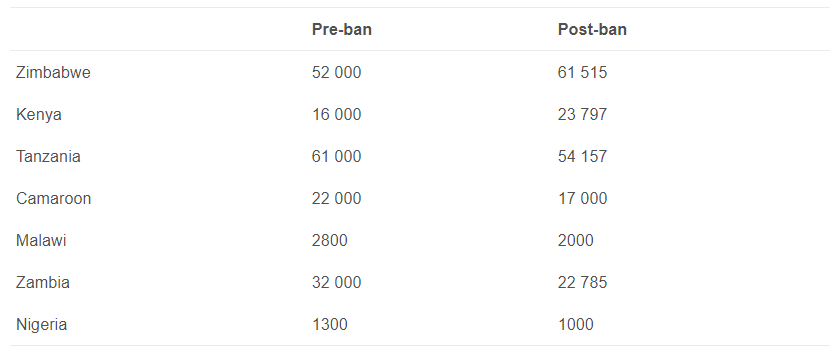
References
- Aryal, A., Morley, C.G. and McLean, I.G., 2018. Conserving elephants depend on a total ban of ivory trade globally. Biodiversity and Conservation, pp.1-9.
- Barbier, E.B., Burgess, J.C., Swanson, T.M. and Pearce, D.W., 2013. Elephants, economics and ivory. Routledge.
- Bennett, E.L., 2015. Legal ivory trade in a corrupt world and its impact on African elephant populations. Conservation Biology, 29(1), pp.54-60.
- Blanc, J. 2008. Loxodonta africana. The IUCN Red List of Threatened Species 2008: e.T12392A3339343. http://dx.doi.org/10.2305/IUCN.UK.2008.RLTS.T12392A3339343.en. Downloaded on 30 December 2018.
- Chase, M.J., Schlossberg, S., Griffin, C.R., Bouché, P.J., Djene, S.W., Elkan, P.W., Ferreira, S., Grossman, F., Kohi, E.M., Landen, K. and Omondi, P., 2016. Continent-wide survey reveals massive decline in African savannah elephants. PeerJ, 4, p.e2354.
- Chelliah, K. and Sukumar, R., 2013. The role of tusks, musth and body size in male–male competition among Asian elephants, Elephas maximus. Animal Behaviour, 86(6), pp.1207-1214.
- Chen, M., Liu, W. and Tao, X., 2013. Evolution and assessment on China’s urbanization 1960–2010: under-urbanization or over-urbanization?. Habitat International, 38, pp.25-33.
- Choudhury, A., Lahiri Choudhury, D.K., Desai, A., Duckworth, J.W., Easa, P.S., Johnsingh, A.J.T., Fernando, P., Hedges, S., Gunawardena, M., Kurt, F., Karanth, U., Lister, A., Menon, V., Riddle, H., Rübel, A. & Wikramanayake, E. (IUCN SSC Asian Elephant Specialist Group) 2008. Elephas maximus. The IUCN Red List of Threatened Species 2008: e.T7140A12828813. http://dx.doi.org/10.2305/IUCN.UK.2008.RLTS.T7140A12828813.en. Downloaded on 30 December 2018.
- Douglas-Hamilton, I., 2009. The current elephant poaching trend. Pachyderm, 45, pp.154-157.
- Espinoza, E.O., Mann, M.J. and Goddard, K.W., 1992. Identification guide for ivory and ivory substitutes. WWF-World Wide Fund.
- Fernando, P., Wikramanayake, E., Weerakoon, D., Jayasinghe, L.K.A., Gunawardene, M. and Janaka, H.K., 2005. Perceptions and patterns of human–elephant conflict in old and new settlements in Sri Lanka: insights for mitigation and management. Biodiversity & Conservation, 14(10), pp.2465-2481.
- Foley, C.A.H., Papageorge, S. and Wasser, S.K., 2001. Noninvasive stress and reproductive measures of social and ecological pressures in free‐ranging African elephants. Conservation Biology, 15(4), pp.1134-1142.
- Figure 2. Elizabeth A. and Archie Patrick I. Chiyo, (2011), Effects of poaching on Elephant behavior, genetic structure and population health [ONLINE]. Available at: https://wol-prod-cdn.literatumonline.com/cms/attachment/051c4970-b938-40a5-9710-bb71290028e2/mec_5237_f1.gif [Accessed 21st December 2018].
- Gao, Y. and Clark, S.G., 2014. Elephant ivory trade in China: Trends and drivers. Biological conservation, 180, pp.23-30.
- Gillson, L. and Lindsay, K., 2003. Ivory and ecology—changing perspectives on elephant management and the international trade in ivory. Environmental Science & Policy, 6(5), pp.411-419.
- Gobush, K.S., Mutayoba, B.M. and Wasser, S.K., 2008. Long‐term impacts of poaching on relatedness, stress physiology, and reproductive output of adult female African elephants. Conservation Biology, Vol. 22, 1590-1599.
- Hayward, M.W. and Kerley, G.I., 2009. Fencing for conservation: restriction of evolutionary potential or a riposte to threatening processes?. Biological Conservation, 142(1), pp.1-13.
- Heltberg, R., 2001. Impact of the ivory trade ban on poaching incentives: a numerical example. Ecological Economics, 36(2), pp.189-195.
- Hilborn, R., Arcese, P., Borner, M., Hando, J., Hopcraft, G., Loibooki, M., Mduma, S. and Sinclair, A.R., 2006. Effective enforcement in a conservation area. Science, 314(5803), pp.1266-1266.
- Hoare, R., 2000. African elephants and humans in conflict: the outlook for co‐existence. Oryx, 34(1), pp.34-38.
- Hollister-Smith, J.A., Poole, J.H., Archie, E.A., Vance, E.A., Georgiadis, N.J., Moss, C.J. and Alberts, S.C., 2007. Age, musth and paternity success in wild male African elephants, Loxodonta africana. Animal Behaviour, 74(2), pp.287-296.
- Ishengoma DRS, Shedlock AM, Foley CAH et al. (2008) Effects of poaching on bull mating success in a free ranging African elephant (Loxodonta africana) population of Tarangire National Park, Tanzania. Conservation Genetics, 9, 247–255.
- Kelso, B.J., 1995. The ivory controversy. Africa Report, 40(2), p.50.
- Ruggiero, R., 1990. The effects of poaching disturbance on elephant behaviour. Pachyderm, Vol. 13, 42-44.
- Sitati, N.W. and Walpole, M.J., 2006. Assessing farm-based measures for mitigating human-elephant conflict in Transmara District, Kenya. Oryx, 40(3), pp.279-286.
- Stiles, D. and Martin, E., 2001. Status and trends of the ivory trade in Africa, 1989–1999. Pachyderm, 30, pp.24-36.
- Stiles, D., 2004. The ivory trade and elephant conservation. Environmental Conservation, 31(4), pp.309-321.
- Underwood, F.M., Burn, R.W. and Milliken, T., 2013. Dissecting the illegal ivory trade: an analysis of ivory seizures data. PloS one, 8(10), p.e76539.
- Vandergrift, J., 2013. Elephant poaching: CITES failure to combat the growth in Chinese demand for ivory. Va. Envtl. LJ, 31, p.102.
- Van-Kooten, G.C., 2008. Protecting the African elephant: a dynamic bioeconomic model of ivory trade. Biological Conservation, 141(8), pp.2012-2022.
- Wasser S, Poole J, Lee P et al. (2010) Elephants, ivory, and trade. Science, 327, 1331–1332.
- Whitehouse, A.M., 2002. Tusklessness in the elephant population of the Addo Elephant National Park, South Africa. Journal of Zoology, 257(2), pp.249-254.
- Weissengruber, G.E., Egerbacher, M. and Forstenpointner, G., 2005. Structure and innervation of the tusk pulp in the African elephant (Loxodonta africana). Journal of anatomy, 206(4), pp.387-393.
- Wu, Y.S., Rupp, S. and Alden, C., 2016. Values, Culture and the Ivory Trade Ban.
(3) “Asian Elephant Distribution Map.” Association of Zoos and Aquariums. 20 Oct. 2009. Web. 23 Apr. 2015.
(4) “African Elephant Distribution Map.” Association of Zoos and Aquariums. 20 Oct. 2009. Web. 23 Apr. 2015.
Cite This Work
To export a reference to this article please select a referencing stye below:
Related Services
View allDMCA / Removal Request
If you are the original writer of this essay and no longer wish to have your work published on UKEssays.com then please click the following link to email our support team:
Request essay removal



